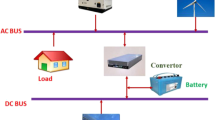Abstract
It is an era of the world in which energy has become an integral part of our day-to-day activities. Because of the challenges imposed by climate change, the focus is on new and renewable sources of energy which opens the avenues for research based on innovative concepts. In this paper, PV-hydro-biomass hybrid power system for on/off-grid applications has been considered as an alternative model as a step toward self-sufficiency of villages in electricity. This system is selected for its low-cost, sustainable, and effective means to utilize natural resources in a rural area. The developed model is applied to the village Baheya of Ranchi district, Jharkhand. The sensitivity analysis along with the simple payback period has been carried out using HOMER Pro optimization software. The results also highlight the environmental impacts of the developed model.
Access this chapter
Tax calculation will be finalised at checkout
Purchases are for personal use only
Similar content being viewed by others
References
Bilal BO, Nourou D, Kebe CMF, Sambou V, Ndiaye PA, Ndongo M (2015) Multi-objective optimization of hybrid PV/Wind/diesel/battery systems for decentralized application by minimizing the Levelized cost of energy and the CO2 emissions. Int J Phys Sci 10(5):192–203
Merei G, Berger C, Sauer DW (2013) Optimization of an off-grid hybrid PV-Wind-diesel system with different battery technologies using genetic algorithm. Sol Energy 97:460–473
Nasiraghdam H, Jadid S (2012) Optimal hybrid PV/WT/FC sizing and distribution system reconfiguration using multi-objective artificial bee colony (MOABC) algorithm. Sol Energy 86(10):3057–3071
Sivasubramani S, Swarup KS (2011) Multi-objective harmony search algorithm for optimal power flow problem. Electr Power Energy Syst 33(3):745–752
Shaw B, Mukherjee V, Ghoshal SP (2011) Seeker optimization algorithm, application to the solution of economic load dispatch problems. IET Gener Transm Distrib 5(1):81–91
Nema P, Nema RK, Rangnekar S (2010) Minimization of greenhouse gases emission by using hybrid energy system for telephony base station site application. Renew Sustain Energy Rev 14(6):1635–1639
Green Convergence. 2018. New SCE Time of Use Rate Periods Will Cut Benefit of Solar by Up to 50%. <https://www.greenconvergence.com/blog/2018/ October/new-sce-time-of-use-rate-periods-will-cut-benefit/>
Nema P, Nema RK, Rangnekar S (2010) PV-solar/wind hybrid energy system for GSM/CDMA type mobile telephony base station. Int J Energy Environ 1(2):359–366
Wang C, Nehrir MH (2008) Power management of a stand-alone wind/photovoltaic/fuel cell energy system. IEEE Trans Energy Convers 23(3):957–967
Pourmousavi SA, Nehrir MH, Sharma RK (2015) Multi-timescale power management for islanded microgrids including storage and demand response. IEEE Trans Smart Grid 6(3):1185–1195
Barley CD, Winn CB (1996) Optimal dispatch strategy in remote hybrid power systems. 58(4–6):165–179
Mdee1 OJ, Kimambo1 CZ, Nielsen TK, Kihedu1 J (2018) Measurement methods for hydropower resources: a review. Water Utility J 18:21–38E.W. Publications
Khan Y ABB India, and IIT Madras to improve microgrid and electricity access in remote areas, Energyworld.com
Balamurugan P, Ashok S, Jose TL (2011) An optimal hybrid wind-biomass gasifier system for rural areas. Energy Sources Part A: Recovery Utilization Environ Eff 33(9):823–832
Nikhil PG, Subhakar D (2013) Sizing and parametric analysis of a standalone photovoltaic power plant. IEEE J Photovoltaics 3(2):776–784
Sharafi M, ELMekkawy TY (2014) Multi-objective optimal design of hybrid renewable energy systems using PSO-simulation based approach. Renewable Energy 68:67–79
Maleki A, Askarzadeh A (2014) Optimal sizing of a PV-wind-diesel system with battery storage for electrification to an off-grid remote region: a case study of Rafsanjan, Iran. Sustain Energy Technol Assess 7:147–153
Tutkun N (2014) Minimization of operational cost for an off-grid renewable hybrid system to generate electricity in residential buildings through the SVM and the BCGA method. Energy Buildings 76:470–475
Atwa YM, Saadany EF, Salma MAA (2010) Optimal renewable resources mix for distribution dystem energy loss minimization. IEEE Trans Power Syst 25:360–370
Wu H, Liu X, Ding M (2014) Dynamic economic dispatch of a Microgrid: Mathematical models and solution algorithm. Electr Power Energy Syst 63:336–346
Ismail MS, Moghavvemi M, Mahlia TMI (2013) Design of an optimized photovoltaic and microturbine hybrid power system for a remote small community: a case study of Palestine. Energy Convers Manage 75:271–281
Power sector at a glance all India (2020) Ministry of Power, GoI. https://powermin.nic.in/en/content/power-sector-glance-all-India
Executive summary on the power sector (2020) Central electricity authority
Trends in India’s Residential Electricity Consumption (2017) Plugging in. https://cprindia.org/news/6519
Physical Progress, Ministry of New and Renewable Energy. https://mnre.gov.in/the-ministry/physical-progress
Ministry of New and Renewable Energy, https://mnre.gov.in/small-hydro
Micro hydropower Systems, Electricity, and Fuels. https://www.energy.gov/energysaver/buying-and-making-electricity/microhydropower-systems
Salman Z, Biomass Gasification Power Systems, Bio-Energy Consult. https://www.bioenergyconsult.com/gasification-systems/
Biogas, Wikipedia, https://vikaspedia.in/energy/energy-production/bio-energy/biogas
Sen P (2015) Dharni: story of one solar village, Green peace. https://www.greenpeace.org/india/en/story/390/dharnai-story-of-one-solar-village/
Lawder MT, Suthar B, Northrop PWC, De S, Hoff CM, Leitermann O, Crow ML, Santhanagopalan S, Subramanian VR (2014) Battery Energy Storage System (BESS) and Battery Management System (BMS) for grid-skale applications. https://depts.washington.edu/maple/pubs/50_IEEE_BESSBMSGrid.pdf
Facts Sheet: Energy Storage (2019) Environmental and energy studies institute. https://www.eesi.org/papers/view/energy-storage-2019
Kaldellis JK, Kavadias KA (2007) Cost-benefit analysis of remote hybrid wind-diesel power stations: case study Aegean Sea islands. Energy Policy 35(3):1525–1538
HOMER® Pro V3.7 (2016) User Manual
Upadhyay S, Sharma MP (2016) Selection of a suitable energy management strategy for a hybrid energy system in a remote rural area of India. Energy 94:352–366
Koutroulis E, Kolokotsa D, Potirakis A, Kalaitzakis K (2006) Methodology for optimal sizing of stand-alone photovoltaic/wind-generator systems using genetic algorithms. Sol Energy 80(9):1072–1088
Alvarez E, Campos AM, Arboleya P, Gutierrez AJ (2012) Microgrid management with a quick response optimization algorithm for active power dispatch. Electr Power Energy Syst 43(1):465–473
Jharkhand State Electricity Regulatory Commission, True-up for FY 2016–17 & FY 2017–18, APR for FY 2018–19 and ARR & Tariff for FY 2019–20
Author information
Authors and Affiliations
Editor information
Editors and Affiliations
Rights and permissions
Copyright information
© 2022 The Author(s), under exclusive license to Springer Nature Singapore Pte Ltd.
About this chapter
Cite this chapter
Mumtaz, N., Awasthi, S.R., Upadhyay, S. (2022). Renewable Energy-Based Microgrid Design Considering the Real-Time Energy Availability. In: Gupta, O.H., Sood, V.K., Malik, O.P. (eds) Recent Advances in Power Systems. Lecture Notes in Electrical Engineering, vol 812. Springer, Singapore. https://doi.org/10.1007/978-981-16-6970-5_38
Download citation
DOI: https://doi.org/10.1007/978-981-16-6970-5_38
Published:
Publisher Name: Springer, Singapore
Print ISBN: 978-981-16-6969-9
Online ISBN: 978-981-16-6970-5
eBook Packages: EnergyEnergy (R0)




